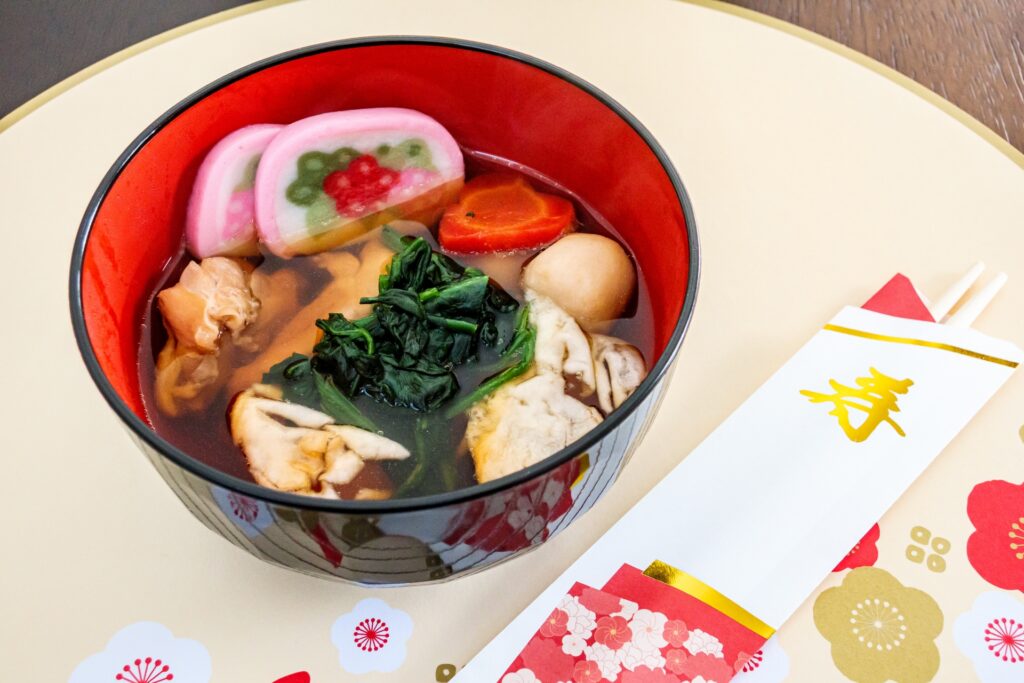New Year in Japan is more than just fireworks or countdown parties—it is a season deeply tied to food, family, and traditions that have been passed down for centuries. Central to this celebration is a special set of dishes known as osechi ryori, along with zoni (New Year soup) and mochi (rice cakes). These foods are more than delicious; each item carries symbolic meaning, such as health, prosperity, or longevity.
What makes it even more interesting for global audiences is how often these New Year foods appear in Japanese anime. From family comedies like Crayon Shin-chan to slice-of-life shows like Lucky☆Star and K-On!, and even Studio Ghibli’s timeless works, anime offers a visual guide to how Japanese people experience the New Year.
In this article, we’ll explore the traditions of Japanese New Year food, then look at how anime brings them to life—sometimes warmly, sometimes humorously, but always with cultural depth.
1. What Is Japanese New Year Food?

Osechi Ryori — The New Year Box
Osechi ryori is the centerpiece of New Year dining. Traditionally served in a multi-tiered lacquer box called a jubako, each dish has symbolic meaning:
- Kuromame (black beans) — for health and hard work
- Kazunoko (herring roe) — for fertility and prosperity
- Datemaki (rolled omelet) — for success in learning and knowledge
- Kombu maki (rolled kelp) — a wordplay on “yorokobu,” meaning joy
Stacking the layers of the box is itself symbolic: it represents “piling up” happiness and good fortune for the year ahead.
Zoni — New Year Soup with Regional Flavors
Zoni is a soup with rice cakes and vegetables, but its preparation varies by region:
- Eastern Japan (Kanto): square grilled mochi in a soy sauce–based clear broth
- Western Japan (Kansai): round boiled mochi in a white miso broth
This regional diversity shows how food reflects local history and traditions.
Mochi & Kagami Mochi — The Sacred Rice Cake
Mochi is everywhere during New Year. Families display kagami mochi—two stacked rice cakes topped with a mandarin orange—as an offering to the New Year deity. Later, it is broken and eaten in a ritual called kagami biraki, symbolizing good health.
At the same time, mochi is a source of humor in popular culture. Its stickiness is notorious—often turned into a comedic gag in anime.
New Year Drinks — Otoso & Amazake
New Year is also celebrated with drinks. Otoso is a spiced sake believed to ward off evil spirits, while amazake is a sweet fermented rice drink enjoyed by children and adults alike.
2. Japanese New Year Food in Anime
Family Warmth: Crayon Shin-chan
New Year episodes often show the Nohara family gathered around osechi or zoni. While the comedy is front and center, the lacquer boxes, chopsticks, and decorations offer a cozy glimpse into Japanese family life during the holiday.
Slice-of-Life Humor: Lucky☆Star
Characters lounge in a kotatsu, snack on osechi, and head out for the first shrine visit (hatsumode). For many international viewers, these feel like cultural lessons wrapped in everyday humor.
Friendship & Fresh Starts: K-On!
The band members share zoni at New Year. Warm scenes of friends eating together highlight food as a symbol of bonding and new beginnings.
Comedy with a Twist: Gintama
From mochi mishaps to over-the-top skits about osechi, Gintama turns tradition into comedy gold—exaggerated yet rooted in real customs.
Cultural Symbolism: Studio Ghibli
Ghibli films showcase food as a symbol of life and tradition:
- Spirited Away: Chihiro’s parents greedily eat mysterious dishes and turn into pigs—a striking commentary on indulgence and respect for food.
- My Neighbor Totoro: Simple family meals connect the characters to nature and rural life.
Though not strictly New Year stories, these scenes show how food in Japanese storytelling is tied to community, respect, and the natural cycle of life.
3. The Deeper Meaning of New Year Food in Anime

- Family anime anchors togetherness with osechi and zoni.
- Youth & friendship anime use shared meals to symbolize growth and fresh starts.
- Comedy anime turns cultural quirks—like sticky mochi—into jokes.
- Ghibli frames food as a universal symbol of care and respect for life.
For international fans, anime becomes more than entertainment—it acts as a cultural guidebook, revealing values like family bonds, seasonal rituals, and nature-minded living.
4. Conclusion
Japanese New Year food—osechi ryori, zoni, and mochi—is a tradition rich in meaning. Each dish carries wishes for health, prosperity, and happiness. Anime brings these customs to life in ways that are funny, touching, or deeply symbolic.
From the family chaos of Crayon Shin-chan and the slice-of-life warmth of Lucky☆Star, to K-On!’s friendship, Gintama’s comedy, and Studio Ghibli’s quiet symbolism, these stories show that food is more than sustenance—it’s culture, memory, and identity.
Next time you watch a New Year episode, look for the osechi box, the zoni bowl, or the mochi on the table—they’re windows into Japanese tradition.
🌏 Explore more about Japanese culture and anime on our Home Page


コメント